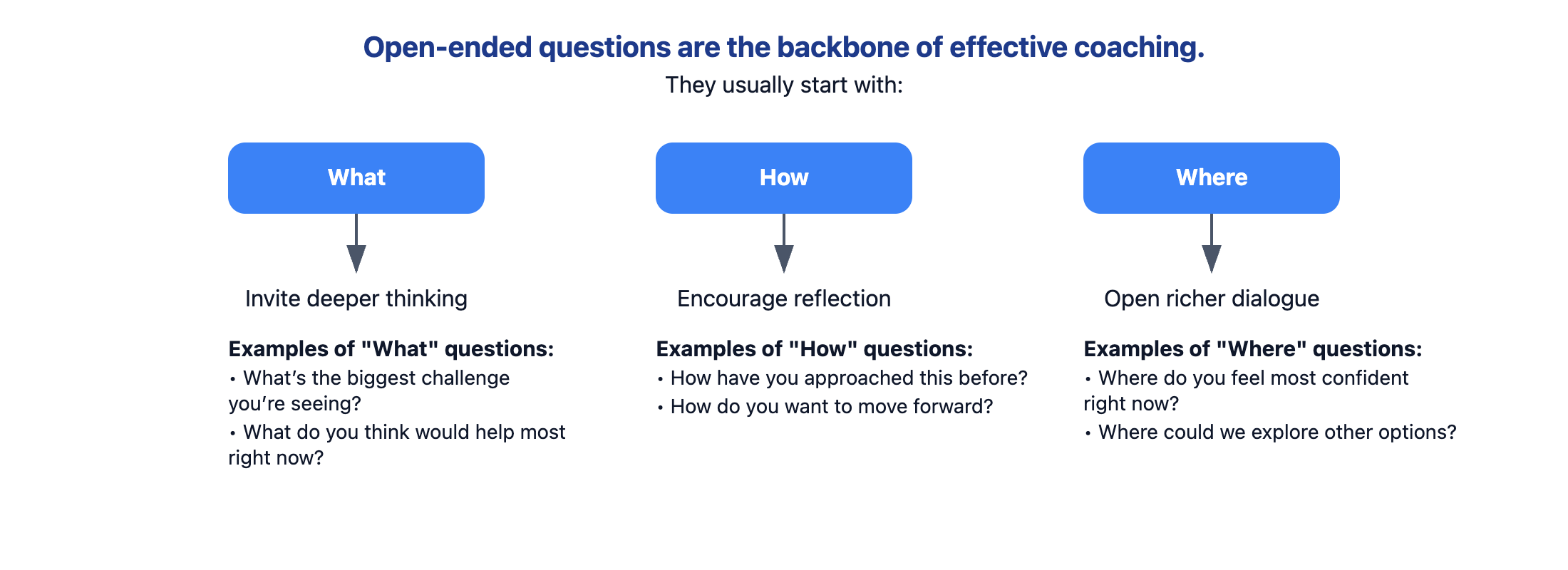The shift from telling to asking is one of the hallmarks of an effective coach. Managers who adopt a coaching mindset create cultures of continuous learning, greater innovation, and stronger employee engagement. As you begin this unit, you’ll explore how the questions you ask can either unlock insight and accountability—or unintentionally shut them down.
At the heart of this approach is questioning with intention. Open-ended questions invite people to critically think and articulate their own perspectives. They encourage ownership, problem-solving, and self-discovery. In contrast, leading or closed-ended questions tend to restrict responses, reinforce dependency on the manager, or subtly steer the person toward a pre-determined answer.
One of the most effective ways to shift from closed or leading questions to open-ended ones is to focus on how you begin your questions. Starting with “what,” “how,” or “where” encourages broader thinking and invites more thoughtful responses. The graphic below illustrates how rephrasing even simple questions can open up richer dialogue and support a coaching mindset.

For example:
- “Did you finish the task?” becomes: “What progress have you made so far?”
- “Don’t you think you should talk to the client?” becomes: “What options have you considered for addressing the client’s concerns?”
This shift transforms a status check into a learning opportunity and communicates trust in your team’s judgment.
To support your team in becoming more thoughtful and self-reliant, keep a set of go-to coaching questions, such as:
- “What’s the real challenge here for you?”
- “How are you thinking about next steps?”
- “Where do you feel blocked, and what might help you move forward?”
It’s common to default to yes/no or leading questions, especially when you’re pressed for time or already have a solution in mind. However, these types of questions can limit learning and stifle honest conversation. For instance, “Are you having trouble with the new process?” may only yield a brief answer or even defensiveness. In contrast, “What’s your experience been with the new process so far?” opens the door to richer feedback and greater trust.
As a rule of thumb:
- Avoid questions that imply a “right” answer, affirm your assumptions, or limit the other person's response.
- Do ask questions that open up possibility, explore perspective, and build agency.
Here’s a short dialogue that demonstrates the difference:
- Chris: Hey Jake, did you get the report done?
- Jake: Not yet. I’ve been caught up with other things.
- Chris: Understood. What progress have you made so far, and where are you running into challenges?
- Jake: I’ve outlined the main sections, but I’m stuck on the budget part.
- Chris: What options have you considered for tackling the budget section?
- Jake: I thought about reaching out to finance, but I wasn’t sure if that was the right move.
- Chris: How might connecting with finance help you move forward?
- Jake: They could clarify the numbers, which would help me finish the proposal faster.
In this exchange, Chris moves from a closed question to open-ended prompts, encouraging Jake to reflect, identify obstacles, and generate his own solutions. Notice how questions like “What progress have you made so far, and where are you running into challenges?” and “What options have you considered?” invite deeper thinking and ownership, rather than simply checking for completion.
As you practice these skills, you’ll notice your conversations becoming more meaningful and your team more self-directed. In the upcoming role-play session, you’ll have the chance to apply these techniques and see firsthand how powerful questions can unlock new insights.
